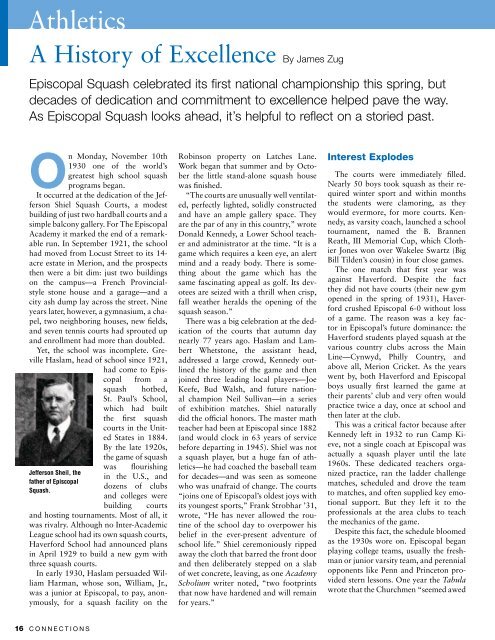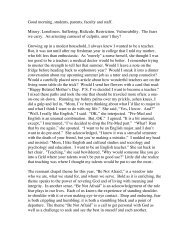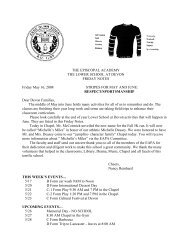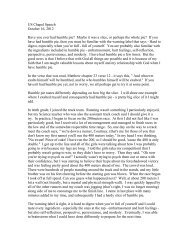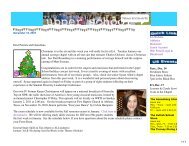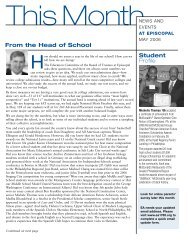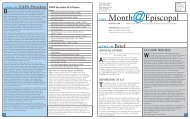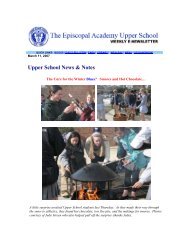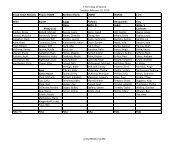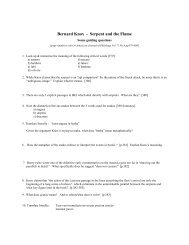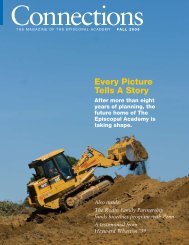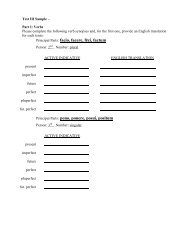The Birth of Team 2234 The Birth of Team 2234 - Episcopal Academy
The Birth of Team 2234 The Birth of Team 2234 - Episcopal Academy
The Birth of Team 2234 The Birth of Team 2234 - Episcopal Academy
Create successful ePaper yourself
Turn your PDF publications into a flip-book with our unique Google optimized e-Paper software.
Athletics<br />
A History <strong>of</strong> Excellence By James Zug<br />
<strong>Episcopal</strong> Squash celebrated its first national championship this spring, but<br />
decades <strong>of</strong> dedication and commitment to excellence helped pave the way.<br />
As <strong>Episcopal</strong> Squash looks ahead, it’s helpful to reflect on a storied past.<br />
On Monday, November 10th<br />
1930 one <strong>of</strong> the world’s<br />
greatest high school squash<br />
programs began.<br />
It occurred at the dedication <strong>of</strong> the Jefferson<br />
Shiel Squash Courts, a modest<br />
building <strong>of</strong> just two hardball courts and a<br />
simple balcony gallery. For <strong>The</strong> <strong>Episcopal</strong><br />
<strong>Academy</strong> it marked the end <strong>of</strong> a remarkable<br />
run. In September 1921, the school<br />
had moved from Locust Street to its 14-<br />
acre estate in Merion, and the prospects<br />
then were a bit dim: just two buildings<br />
on the campus—a French Provincialstyle<br />
stone house and a garage—and a<br />
city ash dump lay across the street. Nine<br />
years later, however, a gymnasium, a chapel,<br />
two neighboring houses, new fields,<br />
and seven tennis courts had sprouted up<br />
and enrollment had more than doubled.<br />
Yet, the school was incomplete. Greville<br />
Haslam, head <strong>of</strong> school since 1921,<br />
had come to <strong>Episcopal</strong><br />
from a<br />
squash hotbed,<br />
St. Paul’s School,<br />
which had built<br />
the first squash<br />
courts in the United<br />
States in 1884.<br />
By the late 1920s,<br />
the game <strong>of</strong> squash<br />
Jefferson Sheil, the<br />
father <strong>of</strong> <strong>Episcopal</strong><br />
Squash.<br />
was flourishing<br />
in the U.S., and<br />
dozens <strong>of</strong> clubs<br />
and colleges were<br />
building courts<br />
and hosting tournaments. Most <strong>of</strong> all, it<br />
was rivalry. Although no Inter-Academic<br />
League school had its own squash courts,<br />
Haverford School had announced plans<br />
in April 1929 to build a new gym with<br />
three squash courts.<br />
In early 1930, Haslam persuaded William<br />
Harman, whose son, William, Jr.,<br />
was a junior at <strong>Episcopal</strong>, to pay, anonymously,<br />
for a squash facility on the<br />
Robinson property on Latches Lane.<br />
Work began that summer and by October<br />
the little stand-alone squash house<br />
was finished.<br />
“<strong>The</strong> courts are unusually well ventilated,<br />
perfectly lighted, solidly constructed<br />
and have an ample gallery space. <strong>The</strong>y<br />
are the par <strong>of</strong> any in this country,” wrote<br />
Donald Kennedy, a Lower School teacher<br />
and administrator at the time. “It is a<br />
game which requires a keen eye, an alert<br />
mind and a ready body. <strong>The</strong>re is something<br />
about the game which has the<br />
same fascinating appeal as golf. Its devotees<br />
are seized with a thrill when crisp,<br />
fall weather heralds the opening <strong>of</strong> the<br />
squash season.”<br />
<strong>The</strong>re was a big celebration at the dedication<br />
<strong>of</strong> the courts that autumn day<br />
nearly 77 years ago. Haslam and Lambert<br />
Whetstone, the assistant head,<br />
addressed a large crowd, Kennedy outlined<br />
the history <strong>of</strong> the game and then<br />
joined three leading local players—Joe<br />
Keefe, Bud Walsh, and future national<br />
champion Neil Sullivan—in a series<br />
<strong>of</strong> exhibition matches. Shiel naturally<br />
did the <strong>of</strong>ficial honors. <strong>The</strong> master math<br />
teacher had been at <strong>Episcopal</strong> since 1882<br />
(and would clock in 63 years <strong>of</strong> service<br />
before departing in 1945). Shiel was not<br />
a squash player, but a huge fan <strong>of</strong> athletics—he<br />
had coached the baseball team<br />
for decades—and was seen as someone<br />
who was unafraid <strong>of</strong> change. <strong>The</strong> courts<br />
“joins one <strong>of</strong> <strong>Episcopal</strong>’s oldest joys with<br />
its youngest sports,” Frank Strobhar ’31,<br />
wrote, “He has never allowed the routine<br />
<strong>of</strong> the school day to overpower his<br />
belief in the ever-present adventure <strong>of</strong><br />
school life.” Shiel ceremoniously ripped<br />
away the cloth that barred the front door<br />
and then deliberately stepped on a slab<br />
<strong>of</strong> wet concrete, leaving, as one <strong>Academy</strong><br />
Scholium writer noted, “two footprints<br />
that now have hardened and will remain<br />
for years.”<br />
Interest Explodes<br />
<strong>The</strong> courts were immediately filled.<br />
Nearly 50 boys took squash as their required<br />
winter sport and within months<br />
the students were clamoring, as they<br />
would evermore, for more courts. Kennedy,<br />
as varsity coach, launched a school<br />
tournament, named the B. Brannen<br />
Reath, III Memorial Cup, which Clothier<br />
Jones won over Wakelee Swartz (Big<br />
Bill Tilden’s cousin) in four close games.<br />
<strong>The</strong> one match that first year was<br />
against Haverford. Despite the fact<br />
they did not have courts (their new gym<br />
opened in the spring <strong>of</strong> 1931), Haverford<br />
crushed <strong>Episcopal</strong> 6-0 without loss<br />
<strong>of</strong> a game. <strong>The</strong> reason was a key factor<br />
in <strong>Episcopal</strong>’s future dominance: the<br />
Haverford students played squash at the<br />
various country clubs across the Main<br />
Line—Cynwyd, Philly Country, and<br />
above all, Merion Cricket. As the years<br />
went by, both Haverford and <strong>Episcopal</strong><br />
boys usually first learned the game at<br />
their parents’ club and very <strong>of</strong>ten would<br />
practice twice a day, once at school and<br />
then later at the club.<br />
This was a critical factor because after<br />
Kennedy left in 1932 to run Camp Kieve,<br />
not a single coach at <strong>Episcopal</strong> was<br />
actually a squash player until the late<br />
1960s. <strong>The</strong>se dedicated teachers organized<br />
practice, ran the ladder challenge<br />
matches, scheduled and drove the team<br />
to matches, and <strong>of</strong>ten supplied key emotional<br />
support. But they left it to the<br />
pr<strong>of</strong>essionals at the area clubs to teach<br />
the mechanics <strong>of</strong> the game.<br />
Despite this fact, the schedule bloomed<br />
as the 1930s wore on. <strong>Episcopal</strong> began<br />
playing college teams, usually the freshman<br />
or junior varsity team, and perennial<br />
opponents like Penn and Princeton provided<br />
stern lessons. One year the Tabula<br />
wrote that the Churchmen “seemed awed<br />
1946 Squash <strong>Team</strong>. Back row (l to r): Murphy, C. Smith, Dixon, Crawford,<br />
Maxwell, J. Walton. Front row (l to r): Mateer, Ringe, Hentz.<br />
by the sophisticated manners” <strong>of</strong> the<br />
Princeton players.<br />
<strong>The</strong> Inter-Ac was <strong>of</strong>ficially formed for<br />
squash in 1934 and in the early years,<br />
Haverford was dominant. After one<br />
6-0 drubbing, the Scholium reported<br />
that “<strong>Episcopal</strong> seemed afraid to take<br />
chances and in trying to be steady made<br />
their games too s<strong>of</strong>t. It was perhaps this<br />
pretense at steadiness which gave the<br />
spectators the impression that the games<br />
were even.”<br />
By 1940, squash was wildly popular.<br />
Because <strong>of</strong> demand, only sophomores,<br />
juniors, and seniors were allowed to take<br />
it as a winter sport and then only for 40<br />
minutes per week. Architects drew up<br />
blueprints for an additional three singles<br />
and one doubles court, to be tacked on to<br />
the back <strong>of</strong> the Shiel courts. It took two<br />
years and a scaling back <strong>of</strong> plans, but in<br />
1942, <strong>Episcopal</strong> had two more courts.<br />
<strong>The</strong> First Golden Age<br />
Two years later, after an interim season<br />
with Middle School teacher Stuyvesant<br />
Barry as coach, <strong>Episcopal</strong> squash entered<br />
its first golden age under the guidance <strong>of</strong><br />
Fitz Dixon ’42. <strong>The</strong> legendary <strong>Episcopal</strong><br />
man led the Churchmen to their first Inter-Ac<br />
titles, grabbing eight in a row and<br />
winning 58 straight prep school matches.<br />
Dixon was not a squash player, so he recruited<br />
Wally Johnson, the former squash<br />
and tennis coach at Penn, to help train<br />
the boys twice a week. Dixon formalized<br />
the team’s schedule, hosting a preseason<br />
practice week during the Christmas holidays<br />
and taking an annual train trip<br />
<strong>The</strong> 1970 Undefeated Squash <strong>Team</strong><br />
to southern New England to play prep<br />
schools, Yale, and Trinity. He also started<br />
the tradition <strong>of</strong> traveling to Annapolis<br />
to play the Naval <strong>Academy</strong>.<br />
Dixon was a visionary leader. Once, he<br />
saw a boy playing well in the Philly Districts,<br />
the only open junior tournament<br />
in the country at the time. In the gallery,<br />
he asked the boy’s father how long he<br />
had been playing. Two months was the<br />
reply. Would the boy like to go to <strong>Episcopal</strong>,<br />
Dixon then asked. <strong>The</strong> father said<br />
he would, but he could not afford the tuition.<br />
Within weeks Dixon had arranged<br />
for a scholarship (he was then director <strong>of</strong><br />
admission) and the following September<br />
the boy enrolled at <strong>Episcopal</strong>. <strong>The</strong> boy<br />
was Diehl Mateer ’46. Mateer played<br />
number one on the team and lead them<br />
to their first undefeated season and Inter-Ac<br />
title (see photo above). He then<br />
went on to become one <strong>of</strong> the greatest<br />
American squash players in history, winning<br />
two national intercollegiate titles,<br />
three national singles titles, 11 national<br />
doubles titles, and two North American<br />
Opens.<br />
Other standouts from the Dixon era<br />
include John Hentz ’48 who captured<br />
four national doubles titles with Mateer<br />
as a partner; Jimmy Whitmoyer ’49<br />
who won a national doubles title; Roger<br />
Campbell ’51 who won two national intercollegiate<br />
titles; Bill Barhite ’53 who<br />
later coached at Vassar and ran the intercollegiate<br />
squash association; and<br />
Bill Sykes ’54, who was a five-year letter<br />
winner.<br />
That success continued into the late<br />
1950s and early 1960s with players like<br />
the McMullin brothers, David ’55 and<br />
Hunter ’58; Jim Zug ’58, who won the<br />
national junior title and two national<br />
doubles titles; Maurice Heckscher ’60,<br />
who won two national doubles titles and<br />
numerous pro tournament titles; and Bill<br />
Morris ’61 who won the national junior<br />
title one year, beating Heckscher in the finals,<br />
and then lost in the finals the year<br />
after.<br />
<strong>The</strong> Second Golden Age<br />
<strong>The</strong> second golden age <strong>of</strong> <strong>Episcopal</strong><br />
squash came in the 1960s and early<br />
1970s. <strong>Episcopal</strong> won the Inter-Ac every<br />
year from 1966 through 1975. Twice,<br />
in 1970 and 1972, they were undefeated.<br />
<strong>The</strong> school completely renovated the<br />
courts in the summer <strong>of</strong> 1965, giving<br />
them their first facelift in a quarter century,<br />
and they again repainted walls and<br />
added new lights (discarding the old Chinese<br />
lantern fixtures) in 1978.<br />
Bringing a fresh approach to the program<br />
were three coaches with strong,<br />
competitive willpower and dazzling oncourt<br />
talent. Tom Poor, a top amateur<br />
player in both singles and doubles, came<br />
to teach at <strong>Episcopal</strong> in 1965 and took<br />
over the then struggling squash team.<br />
He started the immediately prestigious<br />
EA Invitational tournament for local<br />
schools (each got to send four players)<br />
and hosted the 1967 national juniors<br />
tournament. Unwilling to accept the lack<br />
<strong>of</strong> court time, he made the team jump<br />
rope when the courts were full, come<br />
to practice in September, and stay late<br />
into the night. He formed a faculty team<br />
16 Connections spring 2007 17


